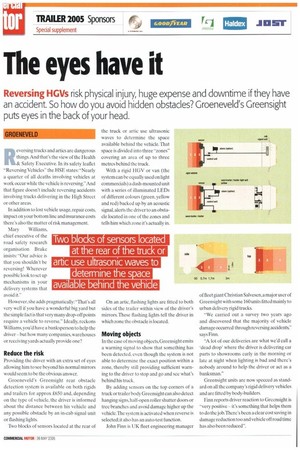The eyes have it
Page 74

If you've noticed an error in this article please click here to report it so we can fix it.
Reversing HGVs risk physical injury, huge expense and downtime if they have
an accident. So how do you avoid hidden obstacles? Groeneveld's Greensight puts eyes in the back of your head.
Reversing trucks and artics are dangerous things. And that's the view of the Health & Safety Executive. In its safety leaflet "Reversing Vehicles" the HSE states: "Nearly a quarter of all deaths involving vehicles at work occur while the vehicle is reversing."And that figure doesn't include reversing accidents involving trucks delivering in the High Street or other areas.
In addition to lost vehicle usage, repair costs, impact on your bottom line and insurance costs there's also the matter of risk management.
Mary Williams, chief executive of the road safety research organisation Brake insists: -Our advice is that you shouldn't be reversing! Wherever possible look to set up mechanisms in your delivery systems that avoid it."
However, she adds pragmatically:"That's all very well if you have a wonderful big yard but the simple fact is that very many drop-off points require a vehicle to reverse." Ideally, reckons Williams, you'd have a banksperson to help the driver but how many companies, warehouses or receiving yards actually provide one?
Reduce the risk
Providing the driver with an extra set of eyes allowing him to see beyond his normal mirrors would seem to be the obvious answer.
Groeneveld's Greensight rear obstacle detection system is available on both rigids and trailers for approx £650 and, depending on the type of vehicle, the driver is informed about the distance between his vehicle and any possible obstacle by an in-cab signal unit or flashing lights.
Two blocks of sensors located at the rear of the truck or artic use ultrasonic waves to determine the space available behind the vehicle. That space is divided into three "zones" covering an area of up to three metres behind the truck.
With a rigid HGV or van (the system can be equally used on light commercials) a dash-mounted unit with a series of illuminated LEDs of different colours (green, yellow and red) backed up by an acoustic signal, alerts the driver to an obstacle located in one of the zones and tells him which zone it's actually in.
On an artic, flashing lights are fitted to both sides of the trailer within view of the driver's mirrors. These flashing lights tell the driver in which zone the obstacle is located.
Moving objects
In the case of moving objects, Greensight emits a warning signal to show that something has been detected, even though the system is not able to determine the exact position within a zone, thereby still providing sufficient warning to the driver to stop and go and see what's behind his truck.
By adding sensors on the top corners of a truck or trailer body Greensight can also detect hanging signs, half-open roller shutter doors or tree branches and avoid damage higher up the vehicle.The system is activated when reverse is selected; it also has an auto-test function.
John Finn is UK fleet engineering manager of fleet giant Christian Salvesen, a major user of Greensight with some 160 units fitted mainly to urban delivery rigid trucks.
-We carried out a survey two years ago and discovered that the majority of vehicle darn age occurred through reversing accidents," says Finn.
"A lot of our deliveries are what we'd call a 'dead drop' where the driver is delivering car parts to showrooms early in the morning or late at night when lighting is bad and there's nobody around to help the driver or act as a banksman."
Greensight units are now specced as standard on all the company's rigid delivery vehicles and are fitted by body-builders.
Finn reports driver reaction to Greensight is "very positive it's something that helps them to do the job.There's been a clear cost saving in damage reduction too and vehicle off road time has also been reduced".












































































































































































































































